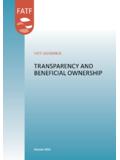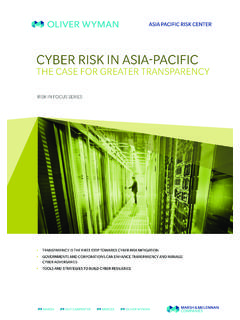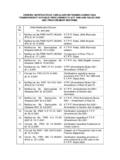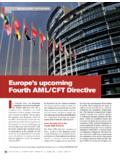Transcription of Transparency International’s Corruption …
1 Transparency international s Corruption perceptions index : whose perceptions Are They Anyway? Discussion Draft Revised March 2005 By Theresa Thompson and Anwar Shah1 1 Theresa Thompson is with the University of Maryland , and Anwar Shah is Lead Public Sector Specialist in the World Bank Institute. The views expressed in this paper are the personal views of the authors alone and should not be attributed to the University of Maryland or the World Bank. The authors are grateful to Johann Lambsdorff of Transparency international for comments on an earlier draft. 1 Introduction: In recent years, Corruption has become an important issue among a wide audience, including development economists, development institutions, politicians and the general public alike. Along with the realization that the quality of a country s institutions is crucial to development have come various empirical studies that have used various Corruption indices in regressions.
2 The widespread usage of the Corruption indices necessitates a closer examination of the reliability of these We find that there are many limitations to Corruption indicators due to the methodologies used in aggregating or averaging, the reliability of the sources on which they are based, and the varying definitions of Corruption utilized. In particular, we find the large standard errors of the aggregate Corruption indices problematic. This lack of precision of the scores leads one to question the feasibility of compiling meaningful rankings across countries or trends across time. The remainder of the paper is organized as follows. The first section of the paper explains the methodology behind one of the more popular indicators, Transparency international s Corruption perceptions index (CPI), as well as its component The second part describes some limitations of the CPI. The final section makes suggestions for future empirical studies of Corruption .
3 Description of the Corruption perceptions index Transparency international s CPI is a composite of various Corruption indicators. It ranks countries on a zero to ten scale, with a score of zero representing very high 2 See Lambsdorff (1999), Lambsdorff (2003a), Lambsdorff (2003b), Habib and Zurawicki (2002). 3 The full list of ratings that make up the CPI from 1995 2003 are listed in Appendix Tables 1-3 and the questions from the components of the 2001 CPI are in Appendix 1. 2 Corruption . Since each source of data about the level of Corruption used a different scale, the scores need to be standardized before being averaged into the Once standardized, each source receives equal weight in the index . In other words, it is the simple mean of the standardized Most of the component indictors only rate Corruption for a sub-set of the countries included in the CPI. Therefore, all of the countries included in a particular year s CPI have not been rated by the same sources.
4 In addition, since results from multiple editions of some sources were used, the ratings of some organizations had a higher weight. For example, in the 2003 CPI, the World Economic Forum s Global Competitiveness Report Corruption scores from 2001, 2002, and 2003 each received equal weight in the CPI as the Economist Intelligence Unit s Country Risk Service and Country Forecast , since only 2003 data was included from the EIU score. The number of sources used in the index tends to change from year to year, as well as the number of countries scored (see table 1 below). Some sources such as Business international and Wall Street Journal Central European Economic Review (CEER) are used in only one year s CPI, while other sources such as the World Competitiveness Report and the Asian Intelligence Issues are included in all years from 1995 until 2003. Appendix tables 1 3 in the appendix lists all the sources used in each year s CPI. From 1995 to 1997, in order for a country to be rated by Transparency international , there had to be at least four sources of information about Corruption in that country.
5 Starting in 1998, the minimum number of required surveys was lowered to three. 4 For example, one source rates countries on a 0 6 scale, while another rates on a 0 10 scale. 5 The CPI for country j is calculated as the mean of the standardized Corruption scores for that country: ==jNijijjSNCPI11, where Nj is the number of different Corruption ratings sources for country j. 3 Table 1: CPI 1995 2003: Country Coverage and Sources Year 1995 1996 1997 1998 1999 2000 2001 2002 2003 Number of Countries Included 41 54 52 85 99 90 91 102 133 Number of Indicators 7 10 7 12 17 16 14 15 17 Number of Independent Sources 3 6 6 7 10 8 7 10 13 Source: Various documents available on Transparency international s website Up until 2002, Transparency international (TI) included three years of data (if available) from surveys and only one year in the case of expert assessments.
6 Surveys were averaged, according to TI, in order to lessen sharp variations in the scoring when these deviations are not related to changes in the level of Corruption but rather high-level scandals that have surfaced. In the case of expert opinions, TI stated that only one year s score was included because any change from previous years is the considered to be the product of careful evaluation of changing circumstances in the country by the country The scores given by the country experts do not vary much over time. There were two major changes in the CPI starting with the 2002 edition, having to do with the selection of sources for the component indictors and the methodology used to compute the CPI. Regarding the choice of sources, TI decided to no longer include surveys of the general public, but rather include only expert assessments and surveys of business people. The most significant change to the CPI in 2002 was the procedure used to standardize the scores of the individual Corruption indicators before they are averaged into the CPI (described below).
7 Also, the method for determining the confidence range for each score was modified. Despite changes to the standardization procedure for the 6 Lambsdorff, Background Paper to the 2000 Corruption perceptions index Framework Document, p. 3. 4 component ratings, the final CPI rating for a particular country has always been a simple average of the standardized scores. Current Standardization Procedure (since 2002): The new standardization procedure, referred to as matching percentiles occurs in two steps. The inputs to standardizing a particular indicator are i) rankings of countries covered by that source, and ii) the previous year s CPI scores for that same sub-set of countries. For example, suppose that a particular data source on Corruption for 2003 ranks three countries on their level of Corruption . Then, in the first step of standardization, the best score (lowest Corruption ) from the 2002 CPI for those same three countries becomes the standardized score for the country with the highest ranking (lowest Corruption ) for that particular 2003 source.
8 The second highest score among the 2002 CPI scores for the three countries is applied to the country with the second highest ranking according to the 2003 source, and so on. The second step in the standardization procedure applies a monotone transformation (using a variation on the beta function) to each of the scores. The purpose of this transformation is to prevent different countries CPI scores from converging over time, while maintaining the same ordering of countries and also keeping all of the scores in the 0 10 range. For instance Finland s (rated as the least corrupt country) CPI score would tend to fall over time unless it is always rated as the least corrupt country by all the sources included in the CPI. Likewise, Bangladesh s (rated as most corrupt) CPI score would tend to rise over time unless it is consistently rated as the most corrupt country by 5 all of the sources that include it in its Hence, the monotone transformation helps to maintain dispersion of CPI scores by slightly raising scores of the highest rated countries, and by slightly lowering scores of the lowest rated countries.
9 After the component indicators are standardized, they are averaged to create the CPI rating for each country. In order to create confidence intervals, TI uses a nonparametric bootstrap approach. The Corruption scores for a particular country are sampled 10,000 times (with replacement) in order to calculate a confidence interval for the sample mean. 1995 2001 CPI Standardization Procedure: The objective of the standardization procedure applied to the component indicators of the 1995 2001 versions of the CPI was to ensure that inclusion of a source consisting of a certain subset of countries should not change the mean and standard deviation of this subset of countries in the CPI. 8 The starting point for the standardization procedure was the previous year s CPI. It is best explained by an example. The 2000 Asian Intelligence Issue (from PERC) rated the level of Corruption in 14 countries. In order to standardize each Corruption rating from the Asian Intelligence Issue, one needed the mean and standard deviation of those 14 countries from the1999 CPI, and the mean and standard deviation of the Asian Intelligence Issue 2000 ratings.
10 The formula for calculating the standardized valuejiS for the ith component of CPI ( Corruption rating source) for the jth country was then: 7 Background Paper to the 2003 Corruption perceptions index , pp. 6 7. 8 Lambsdorff, The Transparency international Corruption perceptions index 1999 Framework Document, pg. 20. 6 Where: For example, the 14 countries rated by PERC in the Asian Intelligence Issue formed the sub-group for that Corruption rating. In calculating the standardized value for the 2000 PERC, the ratings for 2000 and 1999 was used as t and t-1 according to the formula for jiS. Limitations of the CPI and its Component Indicators Transparency international s Corruption perceptions index (CPI) is an average of several other Corruption measures. TI compares its Corruption Perception index to a price index and suggests that an aggregation of subjective assessments by heterogeneous groups leads to an accurate measure of Corruption .














